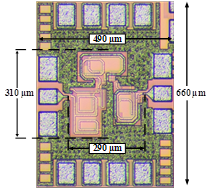Good News∣Reconfigurable Millimeter Wave Chip Research Results of Prof. Xiuyin Zhang's Group Were Published in CICC Conference and JSSC Journal Respectively
2024-05-28
浏览次数:40The IEEE Custom Integrated Circuit Design Conference (2024 CICC) was held from April 21 to 24, 2024 in Denver, Colorado, USA. Our PhD student's reconfigurable millimeter-wave power amplifier chip research “A Tri-mode Filtering Power Amplifier for 5G Millimeter-Wave Dual-Side LO Injection Systems with Power-Efficiency Enhancement” was presented at the conference. The first author of the paper, PhD student Weisen Zeng who enrolled in 2020, gave a live presentation at the conference. The corresponding author was Prof. Xiuyin Zhang. The work was also supervised and supported by Prof. Li Gao and others from the School of Microelectronics.
The paper introduces a reconfigurable millimeter-wave amplifier chip. The mainstream millimeter-wave 5G frequency bands at this stage include 24.25-30 GHz and 37-43.5 GHz. Although the popular ultra-wideband design schemes can cover the above bands, they suffer from the problems of mirror-frequency interference, intrinsic vibration leakage, and high harmonics, as well as the high total power consumption of the ultra-wideband system. Aiming at the above problems, the paper proposes a bilateral LO-injected millimeter-wave 5G reconfigurable front-end chip scheme, which utilizes LO below IF and LO above IF injections to cover the 24.25-30 GHz and 37-43.5 GHz bands, and requires only a narrowband LO module and an RF module. The design effectively reduces the system power consumption requirements. The power amplifier is a key module in the millimeter-wave communication system. For the above frequency scheme, the paper proposes a three-mode reconfigurable power amplifier operating at 22~29 GHz, 24.6~30.4 GHz, and 35~45.2 GHz, which has a compact area. A reconfigurable trap transformer based on shunt inductance is designed to realize low-loss band switching, which solves the problem of excessive loss brought by the traditional series inductance-based reconfigurable transformer, and the switching capacitance of the switching tubes is utilized to synergistically design the trapping function so as to inhibit mirror-frequency signals, intrinsic vibration leakage, and transmission of high-order harmonics. The amplifier has advantages on efficiency and suppression of interference signal transmission.

Fig. 1. Microscopic photograph of reconfigurable amplifier chip
In May 2024, our master's student's reconfigurable millimeter-wave low-noise amplifier chip research, “A Compact Millimeter-Wave Reconfigurable Dual-Band LNA with Image-Rejection in 28-nm Bulk CMOS for 5G Applications” was accepted for publication in the IEEE Journal of Solid-State Circuits (JSSC). The first author of the paper is Ningzheng Sun, a master's student enrolled in 2021, with Prof. Li Gao and Prof. Xiuyin Zhang as co-corresponding authors.
The paper presents a reconfigurable millimeter-wave low-noise amplifier chip. Aiming at the needs of millimeter-wave receivers in future application scenarios, such as cross-band, anti-signal interference, and low power consumption, the paper proposes a dual-band reconfigurable low-noise amplifier operating at 23.8-33.5 GHz and 34.4-41.4 GHz, with a compact chip area suitable for 5G millimeter-wave receiver systems. The interstage matching network and output matching network of the dual-band LNA use reconfigurable capacitors and reconfigurable transformers to switch the operating frequency bands of the circuit, which expands the operating bandwidth of the LNA without increasing the circuit area and power consumption. A triple magnetically coupled switchable transformer is designed to realize band switching, which solves the problem of excessive loss brought by the traditional switching structure, and hardly increases the extra area compared with the ordinary transformer. At the same time, the hybrid magneto-electric coupling circuit is combined with the switchable transformer to introduce a transmission zero point to realize the mirror frequency suppression and at the same time make the position of the transmission zero point switchable, so as to meet the needs of the low-frequency band and high-frequency band to combat the mirror frequency interference. The low-noise amplifier offers advantages in terms of noise figure, bandwidth, power consumption, and mirror-frequency rejection.

Figure 2. Reconfigurable low-noise amplifier chip micrographs
